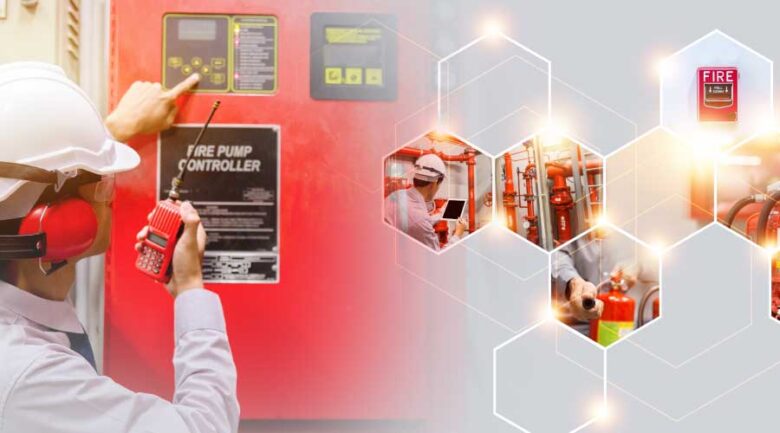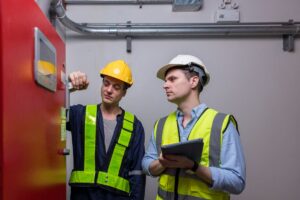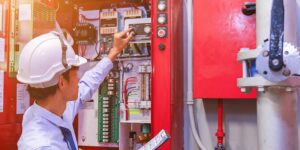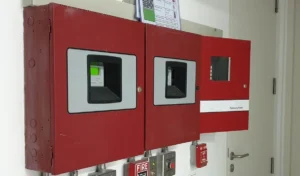As the field of fire safety changes, preparation and being ready are just as important as finding fires and putting them out. It is very important for fire monitoring systems to keep a building’s fire protection systems working and ready to go in case of an emergency. Sprinkler systems, fire pumps, water tanks, and valves are just some of the fire safety tools that these systems keep an eye on all the time. They don’t directly find fire or smoke, but they let people in the building know when there is a problem with the fire control system. This kind of preventative tracking makes sure that fire safety systems work perfectly before, during, and after a fire emergency.
Checking the Functions of Equipment in Real Time
A fire monitoring system is designed to keep an eye on all of the important parts of a fire prevention system and make sure they are all ready to go. This means making sure that all the control valves are open, the fire pumps are turned on and working, the water flow is right, and the security switches are still in place. The control system sends a message if any of these parts fails or is turned off by accident. This real-time feedback lets problems be fixed right away, which often keeps a small problem from turning into a life-threatening one during a fire. It lowers the chance that the system will fail when the equipment is most needed by finding these weaknesses early on.
Stopping mistakes made by people and problems with machines
Human mistake is one of the main reasons why fire safety systems get broken. Maintenance workers could accidentally shut off a power source or close a valve, which would stop the fire control system from working. Over time, mechanical wear and tear can also go unchecked, which can cause parts to leak or break. A fire control system takes away the guessing by keeping an eye on things all the time. It keeps an eye on every part of the system and sounds a warning if something goes wrong, whether it’s because of carelessness, mistake, or worn-out parts. This extra layer of safety helps make sure that all the fire safety parts are working right, even if someone isn’t paying attention or there are technical problems.
Getting ready for emergencies and responding faster
If there is a fire, every second counts. If you wait too long to turn on the fire control system, the fire could spread quickly, cause more damage to property, and put people’s lives at greater risk. Fire control systems make sure that fire prevention systems are always ready, and they let building managers know ahead of time if they aren’t. This not only speeds up the reaction time when a fire happens, but it also keeps things from getting too confusing during the event. Sprinkler systems, alarms, and pumps are all working, so emergency workers can be sure they can do their jobs. Being sure that everyone is ready cuts down on the time it takes from finding a fire to putting it out, which can mean the difference between a limited event and a disaster.
Getting people to follow fire safety rules and codes
Fire monitoring devices are required by many fire safety rules and building laws. This is especially true for business, industrial, and multi-residential buildings. In their guidelines, such as NFPA 72 and NFPA 13, groups like the National Fire Protection Association (NFPA) spell out specific requirements for control devices. Following these rules isn’t just the law; it’s also the right thing to do to make sure people are safe and that the building is managed properly. There is written proof that important safety measures are in place and working with a fire control system. It helps building owners meet inspection requirements, pass checks, and stay out of trouble that could lead to fines or shut-downs.
Making the building safer for residents and first responders
The main purpose of any fire safety plan is to keep people safe. Fire monitoring systems help with this goal by making sure that tools used to put out fires are always in good working order. These methods work better when they’re working right, they put out or control fires faster, giving people more time to leave and firemen less risk. Also, correct control system records help first rescuers figure out what’s going on with the building’s safety systems when they get there. They can make better decisions about how to protect themselves and the people inside the building when they know if the sprinklers have been set off or if the fire pumps are working.
Integration with new technology and building systems
Fire supervision systems today are often built into unified tools for building control. This means that people who work in safety can keep an eye on fire safety systems along with lights, HVAC systems, and security. Alerts can be sent from afar using mobile apps or cloud monitors, so even if support staff are not on-site, they can still respond more quickly. This kind of connection makes things easier to do and makes sure that any problem, no matter how small, is found and fixed right away. This amount of real-time online access is a big step forward in fire safety because it gives building managers and owners more control, awareness, and responsibility.
Lowering the risk and cost of long-term maintenance
Putting in a fire control system costs money up front, but it can save you a lot of money in the long run. By finding problems with equipment early on, the system helps avoid costly emergency fixes, cuts down on system downtime, and lowers the amount of money lost in fires. Insurance companies often see the value in control systems and may lower the rates of buildings that use them. Regular alerts and upkeep notes also make it less surprising when fire checks happen once a year. These methods lower the risk to the building and the people who live or work there by helping to keep a high level of fire ready all the time.
Being able to work with different types of buildings
Fire supervision devices can be used in a lot of different types of buildings. There are many places where they are very useful, such as high-rise apartment buildings, factories, schools, hospitals, office buildings, and shopping malls. Each of these places has its own fire safety needs and ways of setting up its tools. A fire monitoring system can be changed to watch over the exact set of parts that each building needs, no matter what size or purpose it serves. Watching over a complicated network of pumps in a big plant or the sprinkler valves in an apartment building is the same job: making sure that fire safety systems work when they’re needed most.
Building a culture of safety and responsibility
A fire monitoring system does more than just keep things safe; it also encourages people to be careful and take responsibility. When employees know that systems are always being watched, they are more likely to follow safety rules and do regular repair. It’s becoming less important for facility managers to wait for reviews to happen and more important for them to plan ahead. This change in culture can be seen in all companies that put fire safety first, which leads to fewer accidents and a higher level of organizational success. So, fire monitoring systems are both a technology tool and a way to keep people motivated to work toward safety.
In conclusion
These days, fire safety plans can’t work without fire monitoring devices. They make sure that fire control systems are always ready to go by checking the operation of important parts like pumps, valves, and water sources all the time. They help keep tools from breaking down, make sure that building codes are followed, speed up emergency responses, and protect lives and property in the end. The fire control system is a smart, proactive way to keep people safe around fires. It can be part of a high-tech building management system or used on its own as a tracking tool. Putting money into this technology is not only smart, it’s necessary for any building that wants to be safe and resilient in the long run.




